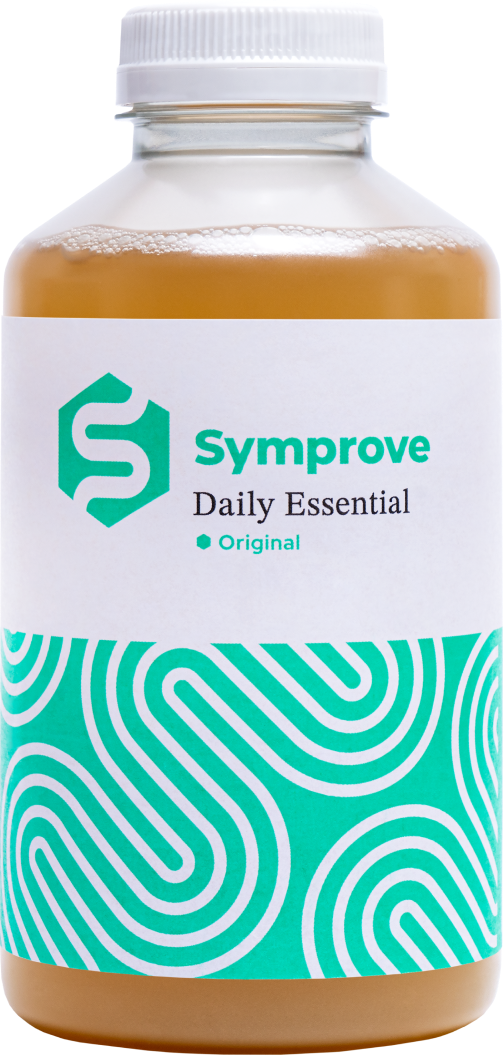Introduction
Chronic low-grade inflammation is a common feature of metabolic syndrome and adiposity. Bacteria and pro-inflammatory bacterial compounds often trigger low-grade inflammation by entering the circulation via faults in gut mucosal and epithelial cell barriers. (1) The gut microbiome plays a critical role in maintaining gut barrier integrity.
Traditional approaches for treating obesity include diet, exercise, drugs and/or surgery all of which have shown varying degrees of success with some concerns about long-term efficacy.
Microbial composition is different in individuals with obesity compared to individuals with normal weight with specific bacterial groups either enriched or decreased. (2)
The gut microbiome composition may be affected by the various interventions for weight management, including diet and exercise, drugs and surgical interventions such as gastric bypass. (3-6) We also now know that variations in the gut microbiome can impact the efficacy of weight management interventions (7-9) and thus manipulation of the gut microbiome could facilitate better long-term weight management.
We now understand that the gut microbiome impacts energy balance through diverse mechanisms affecting both sides of the energy balance equation. (10) This increasing knowledge of how the gut microbiomes contributes to energy metabolism may provide new opportunities for obesity management.
Regulation of energy intake
Much of what we know comes from animal studies;
- The gut microbiome can regulate host energy intake via short-chain fatty acid (SCFA)-mediated hormone secretion. Short chain fatty acids are an important ‘by-product’ of healthy gut microbiome activity, produced when complex carbohydrates are fermented by gut microbiota. (11) Within the gut, SCFAs help to trigger the release of glucagon-like peptide 1 and peptide YY. (11) These hormones promote satiety by activating endocrine receptors in the brain which then process information about nutritional status. SCFAs may further influence energy intake by signalling through the vagus nerve (11) or by crossing the blood–brain barrier and promoting the expression of anorexia-promoting genes. (12)
- Some gut bacteria synthesise peptides that mimic hormones which regulate satiety and hunger, such as leptin and insulin. (13)
- Gut microorganisms can synthesize neurotransmitters such as GABA, dopamine, noradrenaline, and acetylcholine, and influence endogenous levels of serotonin in the intestine and dopamine, noradrenaline and serotonin in the brain. (14) These neurotransmitters influence energy intake through their roles in gut motility, satiation and food reward.
The influence of the gut microbiome on food preferences is especially interesting and will have evolved initially to protect life when high energy-dense food was not as freely available. Germ-free mice, compared to conventional mice, have a higher expression of intestinal receptors for sweet taste and an associated increased sugar intake, (15) as well as an increased preference for fat. This is associated with an increased expression of oral fatty acid receptors and a decreased expression of satiety peptides. (15) If we transplant faecal microbiota from diet-induced obese mice into germ-free recipients, then a blunted preference for high fat high-sugar diets is observed which is associated with reduced food reward. (16)
Metabolic programming by the gut microbiome may occur in utero. (17) A study in mice found that SCFAs from the maternal microbiome cross the placental barrier and trigger the release of glucagon-like peptide 1 in the developing embryo. (18) The pups born to the mothers with microbiomes with limited SCFA production due to germ-free status, low fibre diets or antibiotic treatment had a higher risk of metabolic syndrome when introduced to high-fat diets as adults compared to pups born to mothers with SCFA-producing microbiomes.
Studies in both mice and humans suggest that dysbiosis in early life, through perhaps chronic use of antibiotics, leads to an increased risk of adult adiposity. (19) The metabolic consequences of early-life dysbiosis was found even when microbiome signatures later rebounded to become no different from controls. (20)
Regulation of energy utilisation
Signalling from the gut microbiome to adipocytes directs whether available calories are allocated to thermogenesis or storage. Regulation of energy utilisation occurs via several different mechanisms:
- The SCFAs (butyrate, acetate, propionate) are pivotal in activating fatty acid oxidation and inhibiting lipolysis with reduced fat storage in white adipose tissue. SCFAs also have a beneficial effect on glucose metabolism (21)
- Gut microbial transformations of bile acids (BAs) regulate energy metabolism. (22) BAs transformed by the gut microbiota possess diverse signalling functions with potential downstream effects on nutrient absorption. Additionally, gut microbial BA metabolism plays an important role in regulating thermogenesis. (23)
Diet, physical activity, the gut microbiome and obesity
Diet has a key influence on the gut microbiome profile. (24) However, most diets are complex with many variables affecting microbiome composition, including caloric content, macronutrient and micronutrient composition, preparation and timing of feeding.
Large cohort studies have proven links between diet and microbiome composition. (25) Longitudinal analyses of short-term dietary interventions looking at high-fat low-fibre versus low-fat high-fibre, (24) animal-based versus plant-based, (26) very-low-calorie (27) and high-fibre diets (28) have found diet-induced changes in the gut microbiome in one to two days that were reversible after the ‘diet’ stopped. Such diet-induced ‘plasticity’ suggests the possibility for dietary manipulation of host–microbial interactions to support weight management but also suggests that any dietary change needs to be maintained.
Dietary fibre promotes the growth of SCFA producing organisms although different fibres produce different SCFA profiles. (29) Precision fibre interventions could be used to alter the composition of the SCFAs and thus alter energy metabolism. (8) Isolated fibre supplements such as arabinoxylan and inulin can target growth of bifidobacteria and lactobacilli. (30)
Fermented foods containing live microbes may be beneficial in promoting metabolic health although interpretation of comparative findings from intervention studies is difficult owing to variation in the varying species and strains included. Diets enriched in fermented foods, such as cheese, kefir, yoghurt and kombucha, have been found to enhance gut microbiome composition. (31) A systematic review has found yoghurt consumption to be associated with lower weight, body mass index, waist circumference, body fat and a reduced weight gain but cause–effect relationships remain unclear owing to the many confounding factors in dietary intervention studies. (32) Lactobacillus sakei, a probiotic found in kimchi, has been found to reduce body fat and waist circumference but had no effects on body weight or body mass index when given as a 12-week intervention as part of a randomised, double-blind study in adults living with obesity. (33)
A systematic review and meta-analysis of 13 randomised controlled trials (34) including more than 800 participants found that interventions including either probiotics or fermented foods, (mainly lactobacillus genus), resulted in a significant reduction in body weight (-0.6kg 95% CI) and BMI (-0.27kg/m2 95%CI). Whilst significant these effect sizes are small, the intervention times were relatively short with six of the studies having an intervention period less than 8 weeks. Also only seven of the studies included adults with a raised BMI – either living with overweight or obesity. However, a review (35) looked at the efficacy of interventions delivering probiotics to healthy adults living with overweight or obesity and found significant reductions in body weight, BMI and %fat mass (-0.55kg; -0.30kg/m2 and -0.92% respectively; all 95%CI). There were also benefits observed to some metabolic parameters. Eight of the interventions delivered probiotics in the form of supplements and four, in the form of fermented foods such as kefir, yoghurt and fermented milk. The sub-analyses found that interventions delivering higher dosages or single strains led to greater benefits in terms of body weight. A more recent review (36) again considered the efficacy of probiotics and synbiotics in the form of either supplements or fermented foods in the management of obesity found certain strains of Lactobacillus eg L. curvatus, L. rhamnosus, L. plantarum, L. gasseri and/or with species from the Bifidobacterium genus, led to weight and fat mass loss in adults living with overweight or obesity. This evidence has limitations as around half of the studies included dietary strategies such as a reduced energy intake alongside the inclusion of pro- or synbiotics.
There is much controversy about whether the increasing prevalence of obesity may be linked to the increased intake of ultra-processed foods (UPFs) in the diet (37,38) although the differing opinion is considered likely to be a consequence of the fact that not all UPFs are the same. Additives such as emulsifiers and artificial sweeteners are commonly used in modern-day diets. Although generally recognised as safe, recent studies have found that these compounds may affect the gut microbiome and its contributions to energy metabolism. (39,40) Some emulsifiers such as polysorbate 80 have been observed to disrupt the intestinal mucosa, leading to low-grade inflammation, adiposity and high blood glucose levels in mice. (41) Studies in animals and humans have indicated that sweeteners such as saccharin and sucralose, when given in doses within the acceptable daily intake range, alter the gut microbiome leading to glucose intolerance, weight gain, metabolic abnormalities and inflammation. (40) However, these findings have not been reproduced in follow-up studies although the studies all have methodological limitations. The 2023 WHO guideline on the use of non-sugar sweeteners clearly advises that they should not be used for weight management and that replacing free sugars with non-sugar sweeteners does not help long term weight control. (42)
Whilst diet directly influences the composition of the gut microbiome, the influence of both acute and chronic physical activity is indirect. The gut microbial signatures resulting from exercise differ across studies – we assume due to differences in age, diet, stress levels, exercise type and intensity, species and/or strain and other elements of study design. (43,44) Voluntary wheel running has been found to reproducibly enhance the gut microbial capacity for butyrate production in exercised animals versus sedentary controls. (45) The gut microbiome also differs in composition between active and sedentary humans. (44) Studies have found increases in SCFA concentrations and/or butyrate producing organisms in athletes compared with more sedentary individuals. (46) However, physical activity may increase the abundance of butyrate producing taxa in study participants who are lean but not in those living with obesity. (47) Similarly, physical activity increased Faecalibacterium spp. in participants who were lean but had the opposite effect in participants who were living with obesity. (48) After the intervention endpoint, the changes in the gut microbiome composition were largely reversed following a 6-week sedentary washout period, suggesting a dynamic response.
The higher butyrate production that is seen reproducibly across both human and animal studies may enhance gut barrier integrity and thereby reduce low-grade inflammation, conferring metabolic benefits in cases of overnutrition even if weight loss is not achieved. Exercise may have further benefits through mediation of BA metabolism, (49) and the increase in gut motility and reduced colonic transit time that can influence gut microbiome composition. (50)
The above findings fit well with well-established observations that to lose weight, the diet needs to be considered first followed by a gradual increase in activity levels which can be sustained to support long-term weight maintenance, but that physical activity has wider benefits.
Sleep, stress, the gut microbiome and obesity
Sleep deprivation can affect multiple systems and is associated with an increased risk of obesity. (51) Animal studies have shown that both acute and chronic sleep deprivation can lead to rapid subtle changes in gut microbiota composition. (52) When we get less sleep, specific gut bacteria become more active which promotes increased absorption of calories and energy uptake from foods. (53) Despite the recognised importance of sleep, adults sleep time has reduced over recent years due to many factors, including working longer, increased social demands and the more frequent use of electronic devices late at night. The resulting sleep deprivation negatively impacts our overall health, and the mechanisms may be partially explained by the associated changes to gut microbiota composition.
There is also a strong link between a healthy gut microbiome and a greater level of resilience when a person is faced with stressful situations. (54) It is generally respected that there is a bi-directional relationship between poor mental health and obesity. This relationship may be related to psychologically driven poor eating habits that can negatively impact gut health. Emotional eating is related to unhealthy food intake and abdominal obesity with studies showing those with the greater level of emotional eating tendency consuming fewer fruit, vegetables and legumes and instead consuming more snacks and fast foods with a lower intake of fibre. (55) These preferred food choices, adopted as a means of coping with stress, will alter gut microbiota composition.
Weight management interventions and the gut microbiome
To compare intra-individual microbiota changes following different weight management interventions, researchers have looked at 14 longitudinal studies which included a variety of different interventions including energy restriction, macronutrient manipulation, physical activity and bariatric surgery. (6) Gut microbiota composition was reproducibly altered by the interventions across participants in 12 of the 14 studies. However, it is estimated that interventions predicted 0.6−9.0% of variation in gut microbiota composition, whereas interindividual variation explained 55.2−87.0%. (6)
RYGB surgery was found to have the greatest effect on microbiome composition, followed by energy restriction, nutrient manipulation (eg low CHO, low fat, high protein diets) and physical activity had the least effect. Sub analysis of the dietary interventions showed intermittent fasting, prolonged caloric restriction and ketogenic diets to have the greatest effects on gut microbiota composition, with diets identified as vegetarian or low gluten having less influence. (6)
Surgical treatments for severe obesity may reduce food intake and/or decrease nutrient absorption (5) and the interventions have been shown to increase microbial diversity, increasing the relative abundance of key bacteria. (56, 57) The intervention-associated changes to microbiota composition have been found to affect microbial metabolism leading to a reduced level of adiposity in animal studies. (58) However, evidence suggests that the beneficial effects of surgical intervention on the microbiome could be short-term, with reversion within 1-year post-intervention. (59) This is generally when people start to struggle to maintain their weight loss following surgery. It could be that the gut microbiome composition contributes to the variable weight loss responses seen in individuals post bariatric surgery.
Why individuals differ in their responses to individual diets or weight management interventions such as surgery is difficult to predict. Microbiome science offers the possibility that diets could be tailored according to the microbiome of an individual to improve microbial composition and thus regulate energy balance and clinical efficacy. We also need to be mindful that the role of the gut microbiome is not always to increase energy imbalance. In some instances, the host– microbial system can act as a ‘buffer’ where short-term reductions in energy intake changes the microbiome composition to influence metabolism in a way that increases the contributions to energy status. (60)
Summary/take-home messages
We still have much to learn but:
- The gut microbiome impacts energy balance through diverse mechanisms affecting both sides of the energy balance equation
- Metabolic programming by the gut microbiome may occur in utero and changes in microbiota composition in early life may contribute to childhood obesity which tracks into adult obesity
- Diet has a significant effect on microbiome composition. Changes in diet can have a profound effect but the changes in microbiome composition can be quite quickly reversed.
- Bariatric surgery also has a significant effect on microbiome composition which likely contributes to the early weight loss seen. The microbial composition slowly ‘reverts’ back to the individual’s pre-surgery profile
- Physical activity has a slightly less substantial effect on microbiome composition but nevertheless the impact could be beneficial in helping to maintain weight loss
- Sleep and stress levels also influence gut microbiome composition and thus it is important that these lifestyle factors are considered as part of any weight management intervention
- Going forward, diet/lifestyle/surgical weight management interventions could be tailored according to the individual microbiome composition, but any changes made ideally maintained long-term
- Much more research in the field of the gut microbiome and obesity is needed
References
- Hotamisligil GS. Nature 2006;444:860–7.
- Chatelier E, et al. Nature 2013;500.
- Grembi, JA, et al. Sci Rep 2020;10:1405.
- Ang QY, et al. Cell 2020;181(6):1263-75.
- O'Brien PE, et al. Obes Surg 2019;29(1):3-14.
- Carmody RN, et al. Nat Rev Microbiol 2023;21:535–50.
- Christensen L et al. J Nutr 2019;149(12):2174-81.
- Menni C, et al. Int J Obes 2017;41(7):1099-105.
- Jian C, et al. Genome Med 2022;14:54.
- Cani PD, et al. Current Pharmaceutical Design 2009;15(13):1546–58.
- Silva YP et al. Front. Endocrinol 2020;11:25.
- Byrne CS, et al. Int J Obes 2015;39(9):1331-8.
- Cani PD, et al. Molecular Metabolism 2016;5(9):743-52.
- Chen Y, et al. Nutrients 2021;19;13(6):2099.
- Alcock J, et al. Bioessays 2014;36(10):940-9.
- Ousey J, et al. Curr Biol 2023;33(1):147-57.e7.
- Walter J, et al. Microbiome 2021;9(1):5.
- Kimura I, et al. Science 2020;367(6481):eaaw8429.
- Jian C, et al. eBioMedicine 2021;69:103475.
- Cox LM, et al. Cell 2014;158(4):705-21.
- den Besten G, et al. J Lipid Res 2013;54(9):2325-40.
- Li R, et al. Best Practice & Research Clinical Endocrinology & Metabolism 2021;35(3):101493.
- Agus A, et al. Gut 2021;70:1174-82.
- Wu GD, et al. Science 2011;334(6052):105-8.
- Asnicar F, et al. Nat Med 2021;27:321–32.
- David L, et al. Nature 2014;505:559–63.
- Oliver A, et al. mSystems 2021;6(2):e00115-21.
- Rondanelli M, et al. Front Endocrinol (Lausanne) 2021;12:662591.
- Vinelli V, et al. Nutrients 2022;14(13):2559.
- Lockyer S, et al. Nutr Bull 2019;44:74-91.
- Leeuwendaal NK, et al. Nutrients 2022;14(7):1527.
- Eales J, et al. Int J Obes 2016;40:731–46.
- Lim S, et al. Endocrinol. Metab 2020;35:425–34.
- Borgeraas H, et al. Obesity Reviews 2018;19:219–32.
- Wang Zhi-Bin, et al. Evidence-Based Complementary and Alternative Medicine 2019;3862971.
- Álvarez-Arraño V, et al. Nutrients 2021;13:3627.
- Dicken SJ, et al. Curr Nutr Rep 2024;13:23–38. https://doi.org/10.1007/s13668-024-00517-z
- Valicente VM, et al. Adv Nutr 2023;14(4):718-38.
- Panyod S, et al. Commun Biol 2024;7:749.
- Ruiz-Ojeda FJ, et al. Adv Nutr 2019;10(suppl 1):S31-S48.
- Chassaing B, et al. Nature 2015;519(7541):92-6.
- Use of non-sugar sweeteners: WHO guideline. Geneva: World Health Organization; 2023. Licence: CC BY-NC-SA 3.0 IGO.
- Bonomini-Gnutzmann R, et al. Int J Environ Res Public Health 2022;19(15):9518.
- Mohr AE, et al. J Int Soc Sports Nutr 2020;17(1):24.
- Choi JJ, et al. Environ Health Perspect 2013;121(6):725–30.
- Sales KM, et al. J Sport Health Sci 2023;12(1):36-44.
- Shah S, et al. The FASEB Journal 2023;37:e22882.
- Allen JM, et al. Med Sci Sports Exerc 2018;50(4):747-57.
- Meissner M, et al. Atherosclerosis 2011;218(2):323-9.
- Monda V, et al. Oxid Med Cell Longev 2017:3831972.
- Cooper CB, et al. BMJ Open Sport & Exercise Medicine 2018;4:e000392.
- Poroyko, VA, et al. Scientific Reports 2016;6:35405.
- Liu BN, et al. World J Gastroenterol 2021;27(25):3837-50.
- An E, et al. Nat Mental Health 2024;2:935–50. https://doi.org/10.1038/s44220-024-00266-6.
- Betancourt-Núñez A, et al. Nutrients 2022;14(7):1371.
- Kong LC, et al. Am J Clin Nutr 2013;98(1):16-24.
- Paganelli, FL, et al. Sci Rep 2019;9:10979.
- Tremaroli V, et al. Cell Metab 2015;22(2):228-38.
- Shantavasinkul PC, et al. Surg Obes Relat Dis 2016;12:1640–5.
- Corbin KD, et al. Nat Commun 2023;14(1):3161.



